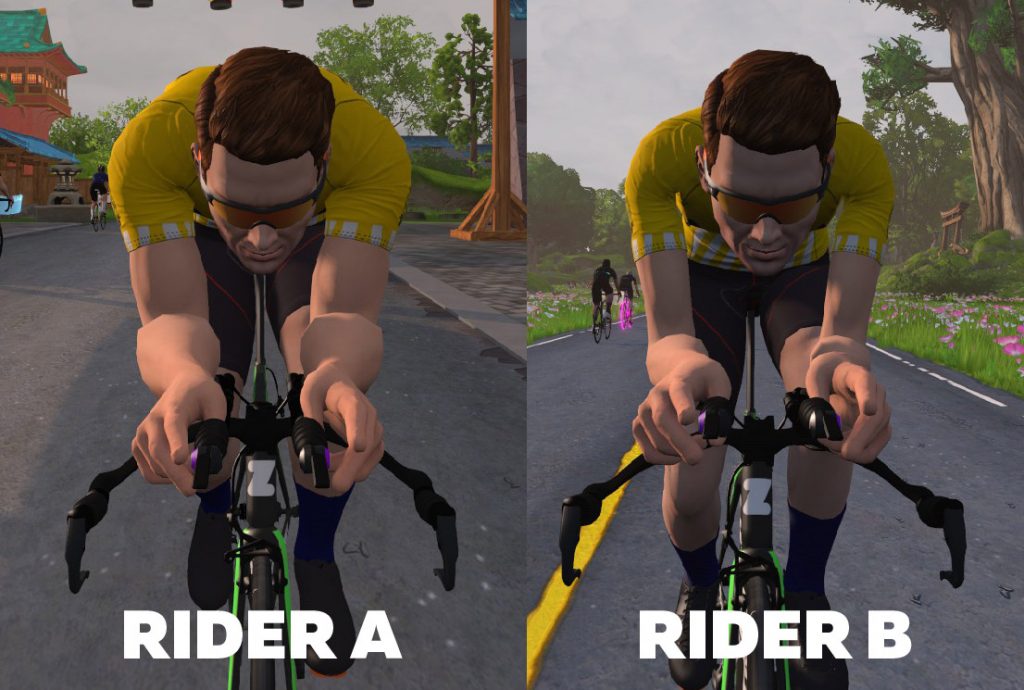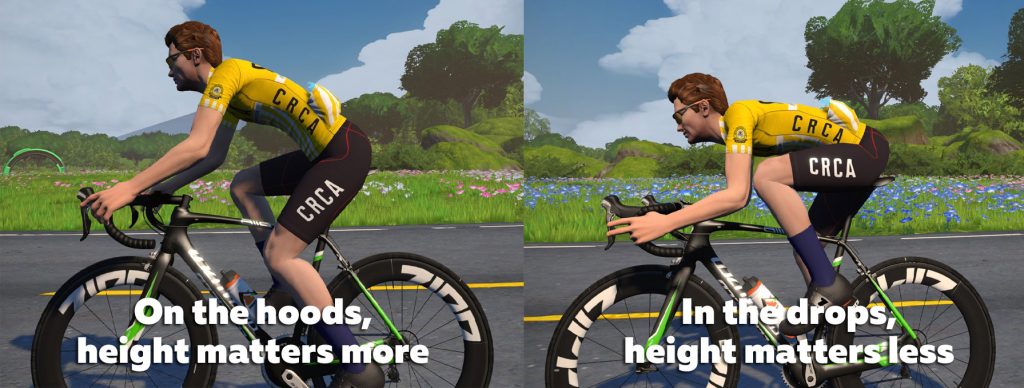Astute Zwifters know the game calculates your virtual bike speed using a combination of “personal” factors (wattage, weight, and height) as well as external factors (bike frame and wheelset choice plus the virtual environment including road surfaces, gradient, etc).
Here at Zwift Insider we’ve done a lot of testing to attempt to tease out the speed effects of each of those factors. We’ve posted about how much each kilogram of weight loss or gained speeds or slows you down, including doing so across a range of w/kg. But we’ve never really done a thorough analysis of how height affects speed – until today!
Zwift racers know that height plays a significant factor in your in-game speed. Simply put, all else being equal, a shorter rider will be faster than a taller rider. But just how much of a difference does it make, across a wide range of wattages and rider heights? Let’s dig in and find out…
Speed Test Data
This chart shows the time it took 6 riders of varying heights to complete our standard flat test course at different power levels. Each rider was set at 75kg weight and used the same virtual bike setup – the only variance across the tests were rider height and wattage.
Height vs Speed at Various Power Levels
Conclusions
- Zwift’s physics hold remarkably steady across a wide range of rider sizes (153cm to 203cm, or approximately 5′ to 6’8″)
- Zwift’s physics hold remarkably steady across a wide range of wattages. We didn’t include it on the chart above, but we also tested at 750W and 1500W, and found the time gaps progressed as we would expect.
- As power increases, speeds increase. As speeds increase, the time gaps between riders of varying heights are reduced.
- For example, at 150W, the different between a 153cm and 203cm rider is 230 seconds. At 450W, those riders are only separated by 159 seconds.
- While the gaps in seconds may change across power levels, in terms of percentage of overall time, these gaps hold pretty steady, with overall time increasing by 5.63% (at 150W) to 5.83% (at 450W) when rider height changes from 153cm to 203cm.
- Why does the percentage difference increase at higher wattages? Because aerodynamics matter more at higher speeds.
- At lower heights, adding a centimeter makes a bigger difference. Going from 193cm to 203cm slows you by approximately 1.06%, but going from 153cm to 163cm slows you by approximately 1.35%. This makes sense, because as you get taller each centimeter is a smaller percentage of your overall height.
- Another way to look at the chart is that it shows how many watts each centimeter of added height costs.
- For example, we can see that 163cm at 150W delivers the same time as 173cm at ~160W. So we know that a rider will need to hold ~10W higher to match a rider 10cm shorter. Or looking at it another way, every centimeter costs 1 watt.
- At higher wattages this cost is even higher, with a 10cm jump costing closer to ~20W in the 450W range.
So how much difference does a centimeter make? Here are estimated numbers based on the chart above:
- At 150W, every added centimeter
- Adds ~4.6 seconds
- Costs ~1 watt
- At 225W, every added centimeter
- Adds ~4.0 seconds
- Costs ~1.1 watts
- At 300W, every added centimeter
- Adds ~3.7 seconds
- Costs ~1.2 watts
- At 375W, every added centimeter
- Adds ~3.4 seconds
- Costs ~1.8 watts
- At 450W, every added centimeter
- Adds ~3.2 seconds
- Costs ~2 watts
I Wish I Were Smaller
Looking at the dramatic effects of height on Zwift speed, the inevitable questions of “height doping” will surface. Is this a real problem on Zwift? Are riders pretending to be midgets so they can win races?
Sure they are. But it’s a very small minority of the serious racing community. (And yes, I wrote that on purpose.)
With WTRL requiring random height verification videos, Zwift Cycling ESports requiring them for top-tier events, and ZwiftPower tracking every rider’s height history, serious racers know that lying about your height can get you into hot water. Quickly. And it’s not like weight, where you can perhaps make the case that you gained or lost 5-10kg in a short amount of time. With height, change is slow and minor. Significant changes stand out quickly in the data, and get riders flagged for cheating.
Is the system foolproof? No. But the system isn’t being overrun by wannabe Cavs, either. Perhaps someday we’ll have a Zwift Racing Passport, where our height can be marked as confirmed after submitting a video?
Should Height Matter So Much?
Whether or not Zwift’s height physics accurately reflect the real world is a matter of some debate. With some online bike speed calculators not even taking rider height into account, why does it figure so heavily into Zwift’s algorithm?
Zwift calculates your avatar’s frontal area based on your weight and height (your BMI, essentially). That frontal area, in turn, is the key factor in Zwift’s CdA calculation, which accounts for the majority of the virtual air resistance your avatar encounters.
At a glance this seems logical – a taller person will be in the wind more, right? But what about the example of two riders who weigh the same, but vary greatly in height?
- Rider A: 160cm tall, 80kg
- Rider B: 190cm tall, 80kg
If both riders hold the same power on flat ground, who would be faster? Our speed tests above show that, at 300W steady, Rider A would be faster on Zwift by approximately 2 minutes over an hour effort due to their reduced height.
But in an aero position with a flat back on a TT bike, Rider A would actually present more frontal area, and therefore be slower in real life. Zwift’s own graphics support this:

It all comes down to rider posture, really. Or at least, it should, if we’re trying to simulate outdoor riding. If Rider A and B are both “on the hoods”, height would matter quite a bit, and it’s reasonable to believe Rider A would be faster due to his reduced frontal area. But if they’re in the drops, height matters less.

Could Zwift change things so your rider’s CdA differs based on avatar posture? Sure they could. But they would need to change the logic which determines when your rider “sits up” or gets into the drops as well.
And would that be the best solution anyway? Possibly not. When you’ve got riders pedaling away in their pain caves in a variety of postures, how should we expect Zwift to fairly decide what everyone’s virtual front area should be?
(It’s worth noting here that calculating your front area in real-time based on a webcam feed showing your posture in your pain cave seems like a super-cool idea, even if it’s a bit before its time…)
It’s easy to say Zwift’s height physics aren’t quite accurate. But it’s also hard to propose a better solution than what they already have in place!
In the end, for better or for worse, Zwift takes a simplistic approach to calculating rider CdA. Some taller riders feel they are unfairly penalized by this, but it’s all part of the game. This is Zwift: a riding simulation. If you want to perfectly replicate outdoor physics, you’ll have to ride outdoors.
Questions or Comments?
Share below!